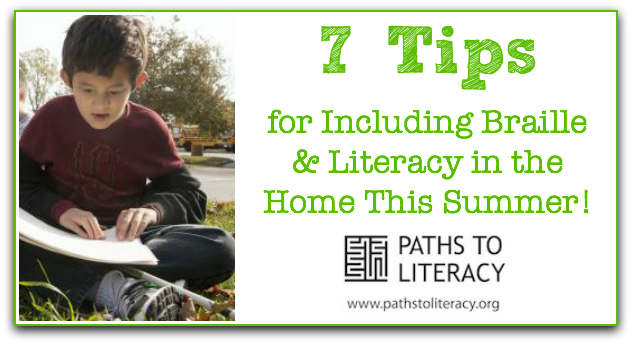Tips to Include Braille and Literacy in the Home This Summer!
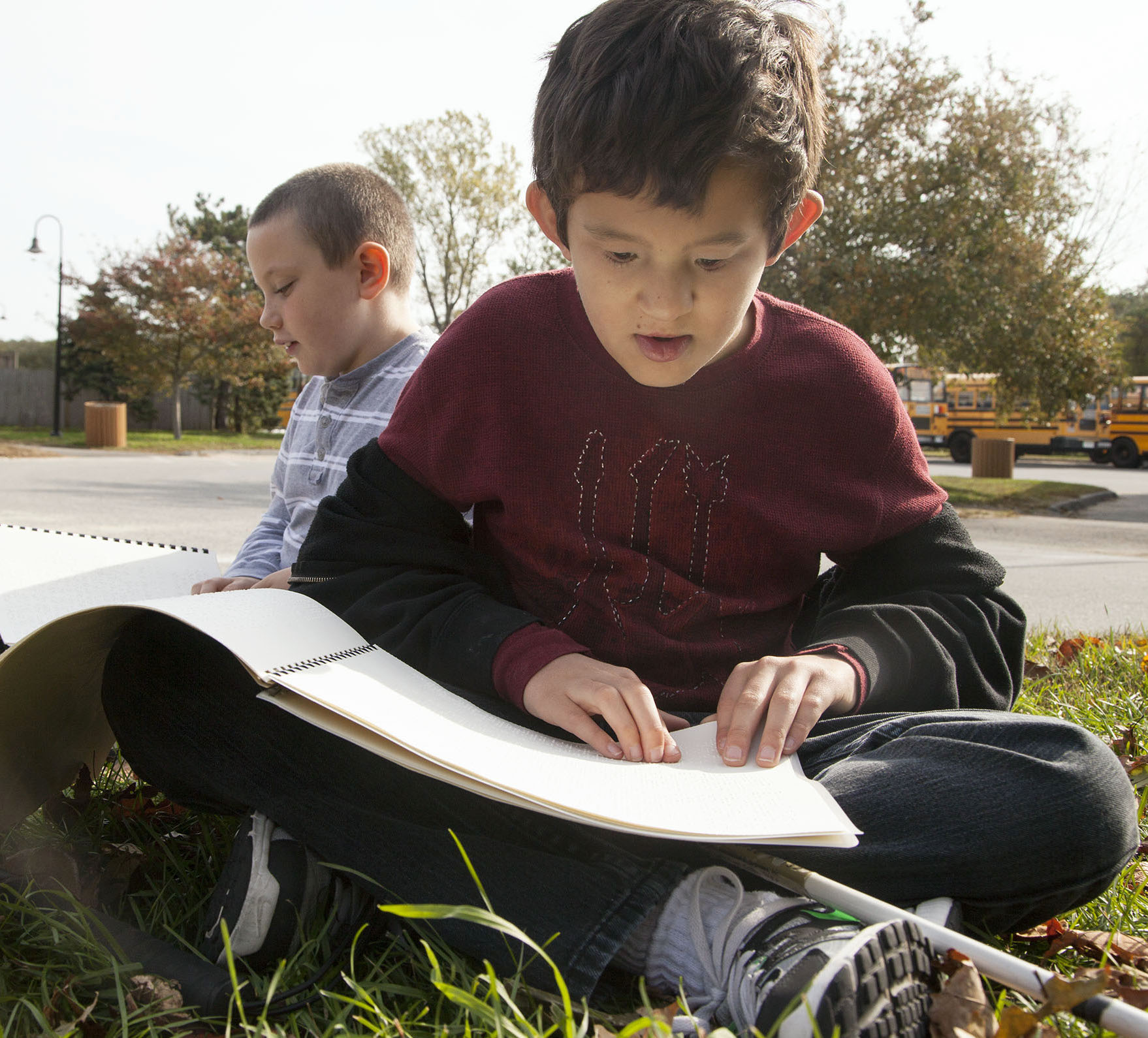
Reprinted with permission of the author.
(Originally published in Spring 2005 SEE/HEAR Newsletter)
Summer vacation is a time that all students look forward to with great anticipation. Days of fun and leisure can add up to boredom, however. Summers can mean long periods of inactivity and isolation for our students with visual impairments, especially those with additional disabilities. Parents, families, and friends can make summer more fun by finding and planning opportunities for kids to read and enjoy books and other literacy activities during the summer. And literacy is not just for students in a standard academic curriculum. Students who may not become independent readers can still benefit from the exposure to print or braille, the spoken vocabulary and the increased exposure to ideas and people that literacy activities provide. Parents don’t have to be good readers themselves, nor do they even have to be good English speakers to help their children improve their reading skills. They just have to believe reading is an important part of a good education, and help their children find access to the books and literacy experiences that are all around them in the community.
-
Be a good role model!
-
Find braille and large print books for leisure reading.
-
Choose the right books.
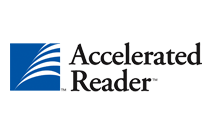 What books should you get? One good place to start choosing books for your child is the Accelerated Reader book list. Accelerated Reader (AR) is a commercially produced product that uses popular children’s books as a source of content, and provides a test for each book on the list. Points are assigned to each book based on level of difficulty, and many schools encourage their students to read books on the list and accumulate points for reading at home. You can search the Accelerated Reader list by author, title, subject, and reading grade level. Many school districts have Accelerated Reader book lists on their websites, you can print the list and take it along when choosing books. Often these lists contain only the books that particular school has in it’s library, so be aware that using the AR website will give you more comprehensive lists. AR does not sell Braille books, so you must make use of other sources to obtain these.
What books should you get? One good place to start choosing books for your child is the Accelerated Reader book list. Accelerated Reader (AR) is a commercially produced product that uses popular children’s books as a source of content, and provides a test for each book on the list. Points are assigned to each book based on level of difficulty, and many schools encourage their students to read books on the list and accumulate points for reading at home. You can search the Accelerated Reader list by author, title, subject, and reading grade level. Many school districts have Accelerated Reader book lists on their websites, you can print the list and take it along when choosing books. Often these lists contain only the books that particular school has in it’s library, so be aware that using the AR website will give you more comprehensive lists. AR does not sell Braille books, so you must make use of other sources to obtain these.-
Read aloud.
-
Establish a regular routine.
-
Listen to audio books.
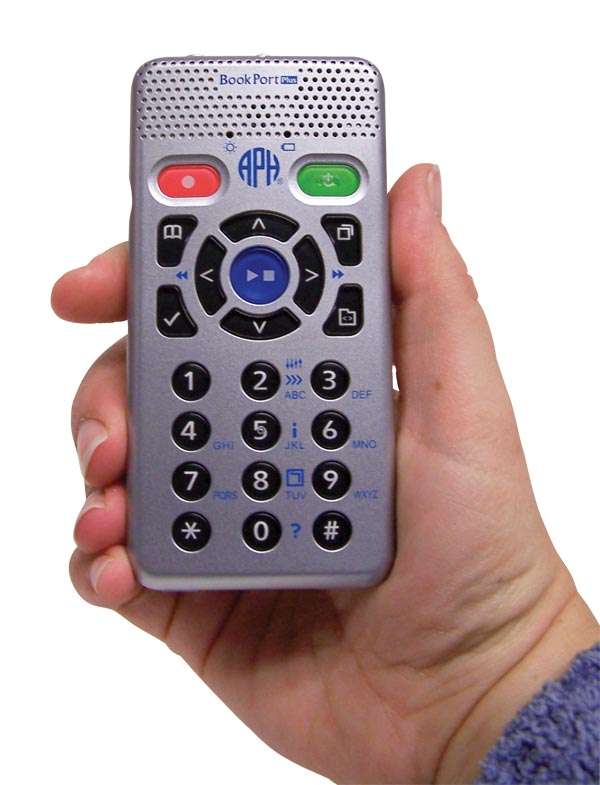 setting, characters and, of course, the subject matter of the book, through listening. Many of our students with visual impairments, whether they are print readers or Braille readers, will use recorded reading materials as they get older and the demands of reading for learning increase. At the college and university level, most books are not available in Braille, so students rely on books recorded for them. Getting the book produced in Braille is usually simply too expensive and too slow to be practical. Children will benefit greatly from learning to be active listeners of recorded content, not just passive listeners of noise. Vision teachers, and sometimes others such as speech pathologists and classroom teachers may work on teaching students to listen for content. This is typically done in a manner similar to teaching reading, the student listens to a passage and answers questions or discusses the content. When more advanced students use recorded material for their school work, they may review the questions that will be asked first before reading the content, they may review an outline provided, or make an outline or summary themselves as they go along. Most parents are familiar with “books on tape.” Our recorded books in school settings are obtained primarily from Recording for the Blind and Dyslexic (RFB&D) (now Learning Ally) which is a resource individuals can access as well, but there are additional sources listed at the end of this article. With the development of technology, many audio books from RFB&D are available on compact disc. Recordings are now made according to specific standards called DAISY format. With a book on CD in DAISY format, you need a special CD player and you can scan for specific words to search for information. A listener can enter the page number and jump directly to a specific page, or paragraph or chapter. The players also allow users to speed up the speech without distorting the pitch, since a skilled listener can comprehend content at a rate much faster than ordinary speech.
setting, characters and, of course, the subject matter of the book, through listening. Many of our students with visual impairments, whether they are print readers or Braille readers, will use recorded reading materials as they get older and the demands of reading for learning increase. At the college and university level, most books are not available in Braille, so students rely on books recorded for them. Getting the book produced in Braille is usually simply too expensive and too slow to be practical. Children will benefit greatly from learning to be active listeners of recorded content, not just passive listeners of noise. Vision teachers, and sometimes others such as speech pathologists and classroom teachers may work on teaching students to listen for content. This is typically done in a manner similar to teaching reading, the student listens to a passage and answers questions or discusses the content. When more advanced students use recorded material for their school work, they may review the questions that will be asked first before reading the content, they may review an outline provided, or make an outline or summary themselves as they go along. Most parents are familiar with “books on tape.” Our recorded books in school settings are obtained primarily from Recording for the Blind and Dyslexic (RFB&D) (now Learning Ally) which is a resource individuals can access as well, but there are additional sources listed at the end of this article. With the development of technology, many audio books from RFB&D are available on compact disc. Recordings are now made according to specific standards called DAISY format. With a book on CD in DAISY format, you need a special CD player and you can scan for specific words to search for information. A listener can enter the page number and jump directly to a specific page, or paragraph or chapter. The players also allow users to speed up the speech without distorting the pitch, since a skilled listener can comprehend content at a rate much faster than ordinary speech.-
Play games and enjoy other literacy activities at home.
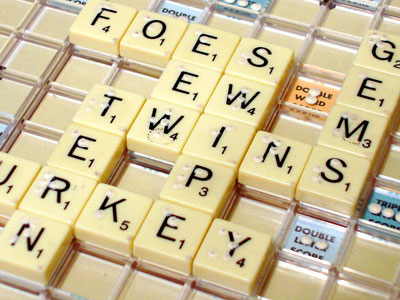 In addition to simply reading books, there are other literacy activities you can do at home. Many games are good for teaching and reinforcing literacy skills, such as Scrabble, Bingo, and Monopoly. You can purchase Braille versions of these games at the websites listed at the end of this article. Some games can also reinforce math skills, and Braille and large print versions of standard playing cards, Uno, and dominoes are all available. Tactile dice are also made. Consider the arithmetic involved in playing Yahtzee and dominoes according to traditional scoring rules. It’s fun and a challenge. Another way to enjoy reading is sending and receiving letters in the mail. Ask your vision teacher if there are other Braille reading students who will become Braille “pen pals” with your child. If your child has attended a special program at Texas School for the Blind and Visually Impaired, a local Education Service Center, summer camp, or other setting and has met other children who use the same reading medium, try to keep them in touch through the mail. Check with the other child’s parent to see if they are willing to encourage and help with the correspondence process. This summer, don’t let the time become a vast wasteland, plan for opportunities for reading, listening to books, discussing books with friends and playing games that practice reading and number skills.
In addition to simply reading books, there are other literacy activities you can do at home. Many games are good for teaching and reinforcing literacy skills, such as Scrabble, Bingo, and Monopoly. You can purchase Braille versions of these games at the websites listed at the end of this article. Some games can also reinforce math skills, and Braille and large print versions of standard playing cards, Uno, and dominoes are all available. Tactile dice are also made. Consider the arithmetic involved in playing Yahtzee and dominoes according to traditional scoring rules. It’s fun and a challenge. Another way to enjoy reading is sending and receiving letters in the mail. Ask your vision teacher if there are other Braille reading students who will become Braille “pen pals” with your child. If your child has attended a special program at Texas School for the Blind and Visually Impaired, a local Education Service Center, summer camp, or other setting and has met other children who use the same reading medium, try to keep them in touch through the mail. Check with the other child’s parent to see if they are willing to encourage and help with the correspondence process. This summer, don’t let the time become a vast wasteland, plan for opportunities for reading, listening to books, discussing books with friends and playing games that practice reading and number skills.Resources
Games
- MaxiAids: Braille Scrabble, Braille Monopoly, Braille dice, Braille Uno, Braille playing cards http://www.maxiaids.com
- LS&S: Braille Bingo, Braille and large print playing cards http://www.lssproducts.com/
Magazines and Newspapers, Book Loans
- The Library of Congress - National Library Service for the Blind and Physically Handicapped (NLS): Through a national network of cooperating libraries, NLS administers a free library program of braille and audio materials circulated to eligible borrowers in the United States by postage-free mail. http://www.loc.gov/nls/
- Texas State Library and Archives Collection - Talking Books Program: Braille magazines and books are available through their loan program https://www.tsl.texas.gov/tbp/gstarted.html
Books
- Dolly Parton's Imagination Library: Free books for qualified parents and teachers of students with visual impairments http://www.aph.org/dolly-partons-imagination-library/
- American Printing House for the Blind (APH) http://www.aph.org
- National Braille Programs: Programs promoting Braille literacy http://www.nbp.org/ic/nbp/programs/index
- Learning Ally: Helping children with reading-related learning disabilities and visual impairments reach their full potential http://learningally.org/
- Seedlings: Braille books for children http://www.seedlings.org/
- Bookshare: An accessible online library for people with print disabilities https://www.bookshare.org/
- Amazon.com: Search the site for Braille Books http://www.amazon.com/
- Future Aids: A store for the blind http://www.braillebookstore.com/
- The National Federation of the Blind https://nfb.org/
Story Tellers
- Tejas Story Telling Association http://www.tejasstorytelling.com/
- Renaissance Learning: Accelerated Reader http://www.renaissance.com/Products/Accelerated-Reader
- TSBVI Braille Book Files http://www.tsbvi.edu/project-services/1978-braille-book-files
